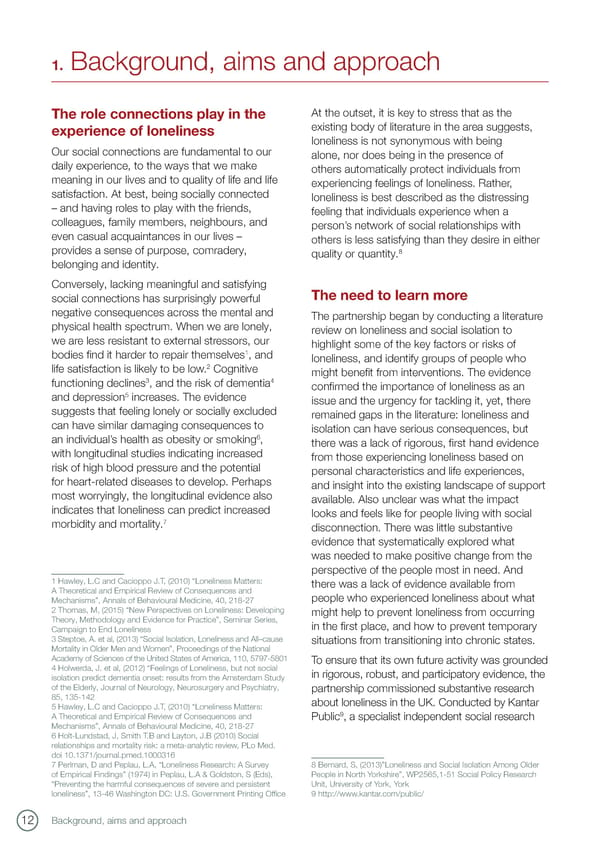1. Background, aims and approach The role connections play in the At the outset, it is key to stress that as the experience of loneliness existing body of literature in the area suggests, loneliness is not synonymous with being Our social connections are fundamental to our alone, nor does being in the presence of daily experience, to the ways that we make others automatically protect individuals from meaning in our lives and to quality of life and life experiencing feelings of loneliness. Rather, satisfaction. At best, being socially connected loneliness is best described as the distressing – and having roles to play with the friends, feeling that individuals experience when a colleagues, family members, neighbours, and person’s network of social relationships with even casual acquaintances in our lives – others is less satisfying than they desire in either provides a sense of purpose, comradery, 8 quality or quantity. belonging and identity. Conversely, lacking meaningful and satisfying social connections has surprisingly powerful The need to learn more negative consequences across the mental and The partnership began by conducting a literature physical health spectrum. When we are lonely, review on loneliness and social isolation to we are less resistant to external stressors, our highlight some of the key factors or risks of bodies find it harder to repair themselves1, and loneliness, and identify groups of people who 2 life satisfaction is likely to be low. Cognitive might benefit from interventions. The evidence 3 4 functioning declines , and the risk of dementia confirmed the importance of loneliness as an 5 and depression increases. The evidence issue and the urgency for tackling it, yet, there suggests that feeling lonely or socially excluded remained gaps in the literature: loneliness and can have similar damaging consequences to isolation can have serious consequences, but 6 an individual’s health as obesity or smoking , there was a lack of rigorous, first hand evidence with longitudinal studies indicating increased from those experiencing loneliness based on risk of high blood pressure and the potential personal characteristics and life experiences, for heart-related diseases to develop. Perhaps and insight into the existing landscape of support most worryingly, the longitudinal evidence also available. Also unclear was what the impact indicates that loneliness can predict increased looks and feels like for people living with social 7 morbidity and mortality. disconnection. There was little substantive evidence that systematically explored what was needed to make positive change from the perspective of the people most in need. And 1 Hawley, L.C and Cacioppo J.T, (2010) “Loneliness Matters: there was a lack of evidence available from A Theoretical and Empirical Review of Consequences and Mechanisms”, Annals of Behavioural Medicine, 40, 218-27 people who experienced loneliness about what 2 Thomas, M, (2015) “New Perspectives on Loneliness: Developing might help to prevent loneliness from occurring Theory, Methodology and Evidence for Practice”, Seminar Series, in the first place, and how to prevent temporary Campaign to End Loneliness 3 Steptoe, A. et al, (2013) “Social Isolation, Loneliness and All–cause situations from transitioning into chronic states. Mortality in Older Men and Women”, Proceedings of the National Academy of Sciences of the United States of America, 110, 5797-5801To ensure that its own future activity was grounded 4 Holwerda, J. et al, (2012) “Feelings of Loneliness, but not social in rigorous, robust, and participatory evidence, the isolation predict dementia onset: results from the Amsterdam Study of the Elderly, Journal of Neurology, Neurosurgery and Psychiatry, partnership commissioned substantive research 85, 135-142 about loneliness in the UK. Conducted by Kantar 5 Hawley, L.C and Cacioppo J.T, (2010) “Loneliness Matters: A Theoretical and Empirical Review of Consequences and 9 Public , a specialist independent social research Mechanisms”, Annals of Behavioural Medicine, 40, 218-27 6 Holt-Lundstad, J, Smith T.B and Layton, J.B (2010) Social relationships and mortality risk: a meta-analytic review, PLo Med. doi 10.1371/journal.pmed.1000316 7 Perlman, D and Peplau, L.A, “Loneliness Research: A Survey 8 Bernard, S, (2013)”Loneliness and Social Isolation Among Older of Empirical Findings” (1974) in Peplau, L.A & Goldston, S (Eds), People in North Yorkshire”, WP2565,1-51 Social Policy Research “Preventing the harmful consequences of severe and persistent Unit, University of York, York loneliness”, 13-46 Washington DC: U.S. Government Printing Office9 http://www.kantar.com/public/ Background, aims and approach 12
 Trapped in a Bubble Page 11 Page 13
Trapped in a Bubble Page 11 Page 13